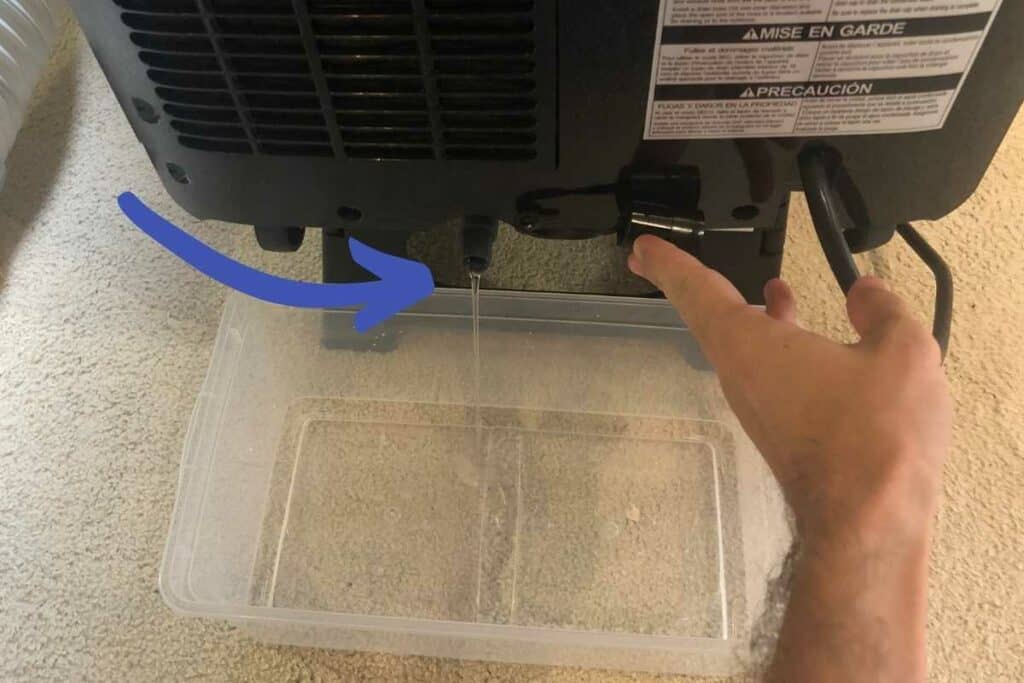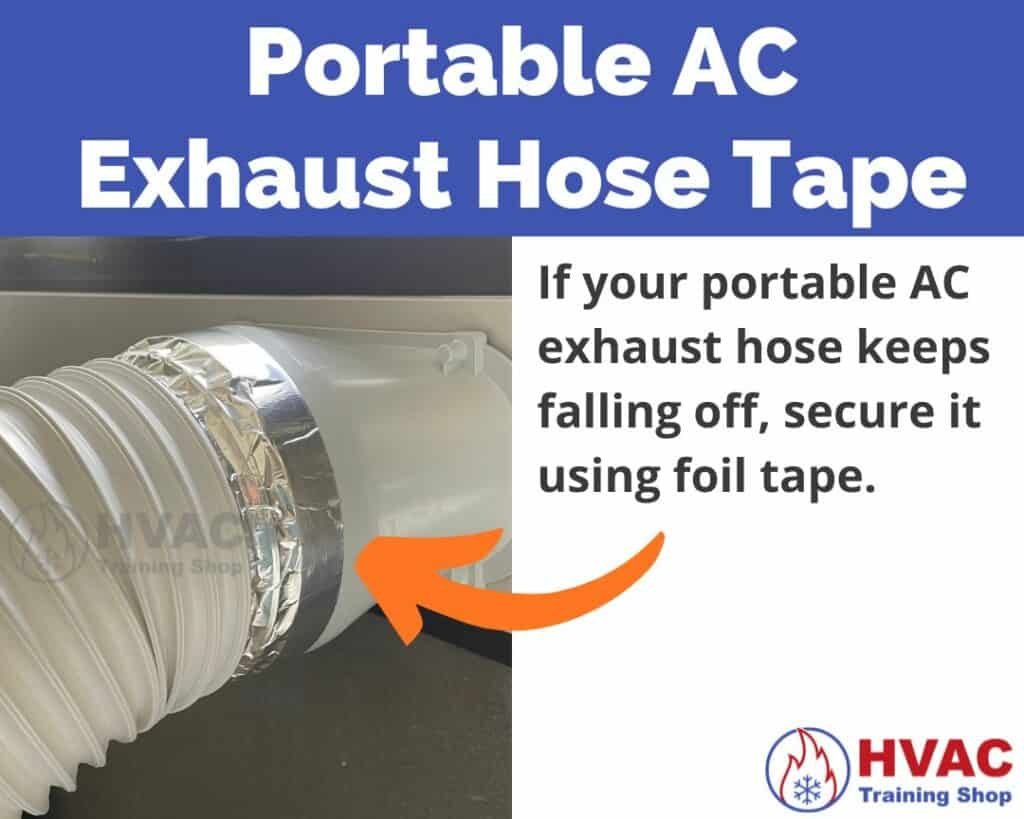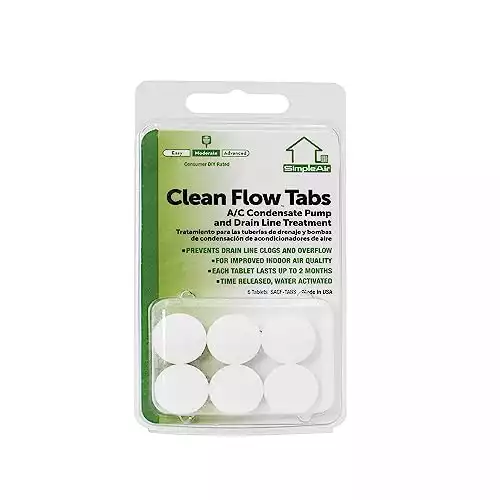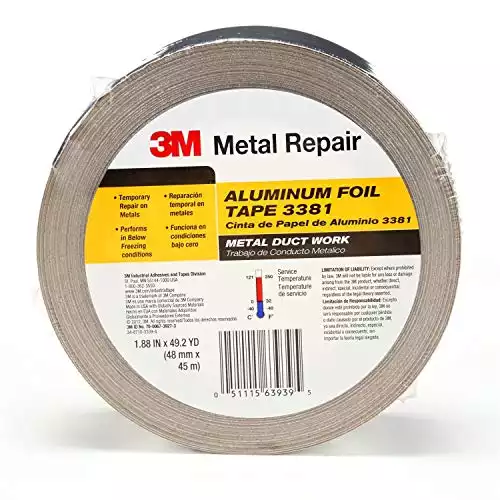HVAC Training Shop is reader-supported. As an Amazon Associate, I earn from qualifying purchases.
Imagine this: You’re sitting comfortably in your room, enjoying the coolness provided by your portable air conditioner during a sweltering summer day.
But suddenly, you feel a slight spray on the back of your neck – your portable AC is spitting out water!
As efficient and convenient as they may be, portable AC units can occasionally present the conundrum of water spitting. This situation can not only be a nuisance but can also create a mess.
However, this isn’t a signal to bid your beloved AC farewell. In most cases, this issue can be tackled with a bit of knowledge and a hands-on approach.
In this article, I’ll go over several potential solutions to fix your portable AC when it’s spitting out water.
I’ll also delve into the various causes of a portable AC that spits water, explaining how you can identify them, understand their impacts, and what you should do to resolve them!
Empty the Condensate Drain Pan

The condensate drain pan is designed to collect the condensation generated during your portable AC’s cooling process.
If neglected, the drain pan can overflow, leading to your portable AC spitting water.
To empty your portable AC’s condensate drain pan, put a container underneath the drain spout on the back of the AC, then open the drain spout to let the water out and into the container.
If your portable AC has two drain spouts, you only need to empty the bottom one (although it doesn’t hurt to empty both of them).
You may need to elevate the portable AC on a step or stool to have enough room to put a container underneath it to collect the water. Your container should be able to hold at least 2 or 3 liters to ensure that water doesn’t spill out all over your floor.
If you open up your portable AC’s drain spout and find that water doesn’t come out, the drain spout may be clogged. Read the section below to find out what to do.
Unclog the Condensate Drain Spout
A clogged condensate drain spout will cause condensate to build up in your portable AC. The buildup of condensate in your portable AC will cause water to spray out when it runs.
If you try to empty your portable AC’s condensate pan or tank by opening the drain spout, but find that nothing comes out, there’s a good chance that the drain spout is clogged.
Fortunately, the drain spout is a short pipe that extends out from the rear of your portable AC, so unclogging it isn’t too much trouble.
Just use a small screwdriver, snake, or even a chopstick to remove the clog and get the water flowing again. Remember to put a container underneath the drain spout to catch any debris and water that come from the spout after unclogging it.
If find that your drain pan and drain spout is full of slime, mold, and mildew, put some drain pan tablets inside of it to prevent future growth and buildup.
Pop one of these Clean Flow tablets into your drain pan every month to keep slime growth away. Comes with 6 tablets so you'll be good for 6 months.
Defrost the Evaporator Coil
A frozen evaporator coil will cause your portable AC to spit out water as the coil thaws out.
Open up your portable AC’s evaporator coil air filter access panel and remove the filter.
Is the coil behind the filter frozen?
If so, let the portable AC sit out for a while to allow the ice to thaw out.
If you want to speed up the process, you can run the portable AC in fan-only mode to thaw the ice out faster.
After your portable AC is defrosted, you’ll be able to run it again without it spitting out water.
But how does an evaporator coil freeze up in the first place?
It’s usually due to one of two things:
- Low airflow
- Refrigerant leak
Low airflow causes the evaporator coil to subcool below freezing temperatures, causing ice to form on the coil. This is usually caused by a dirty air filter or a broken fan motor. So it’s important to clean your portable AC’s air filter at least once a month.
A refrigerant leak will throw off the pressures and temperatures in your portable AC’s refrigerant system, causing the evaporator coil to dip down to lower temperatures than it normally would, causing it to freeze.
Clean the Air Filter
A dirty air filter will cause a reduction in airflow through your portable air conditioner.
A reduction in airflow through your portable AC’s evaporator coil may cause it to freeze up.
The subsequent thawing out of your portable AC will cause an excessive amount of moisture to drip off of the evaporator coil, causing your portable AC to spit out water when it runs.
To clean your portable AC’s air filter, open up the filter access panel on the AC and remove the air filter. Rinse out the air filter using a low-pressure sprayer, like the faucet in your kitchen sink.
Spray out the filter from the back, so that the dust and debris is pushed out of the filter, and not pushed further into the filter.
After the air filter is clean, let it dry before reinstalling it.
Clean the Evaporator Coil
A dirty, grimy evaporator coil can cause moisture to cling to the coil and spit out water.
How does that happen?
Usually, water drips off of the evaporator coil and collects in the condensate collection pan.
But if the evaporator coil is dirty, water won’t drip off and will cling to the coil.
When a dirty coil becomes saturated with moisture, water may spit out of the AC as the fan blows air through the coil.

To clean the evaporator coil, open your portable AC unit’s evaporator coil filter panel and remove the filter. If the coil appears dirty or dusty, cleaning is required.
Using a specialized coil cleaner, spray the coil, taking care not to damage the delicate fins. Let the foaming action dislodge the dust and debris.
For stubborn dust and grime, a soft-tipped nylon brush works well to scrub the coil.
Afterward, rinse out the coil with water and let the coil dry completely before turning the AC back on.
Troubleshoot the Float Switch

A small – but important – component of your portable AC is its float switch. The float switch’s primary function is to prevent water from overflowing out of your portable AC when its condensate pan or tank gets full.
If the float switch is defective, it can lead to excess water in your portable AC’s condensate pan and spitting out of your portable AC.
To test if your float switch is broken, you’ll need to test it with a multimeter. The wires coming out of the float switch should form a closed circuit when the float is down, and an open circuit when the float is up (or vice versa).
Trying to bypass the float switch by connecting both of its wires together is not a solution—the float switch is there to protect your unit (and your home) from potential water damage.
Check the Exhaust Air Hose for Leaks
The exhaust air hose on your portable AC is responsible for moving hot humid air from the inside of your home to the outside of your home.
If your portable AC’s exhaust air hose is leaking, then humid air will come right back into your home. This can potentially cause condensation and spitting from the air outlet of your portable AC as the hot humid air from the exhaust hose interacts with the cold vent on your portable AC.
If your portable AC’s exhaust air hose is leaking or falling off, use some aluminum foil tape to seal off the leak.

Check the Humidity Level Inside Your Home
Finally, sometimes nothing is wrong with your portable AC itself – it just might not be big enough to cool down your home.
If your AC unit’s dehumidifying capacity is overwhelmed by high indoor humidity levels, the excess moisture can lead to the spitting of water from your portable AC.
One solution is to use a dehumidifier when necessary to aid in the portable AC’s dehumidification.
Another thing to do is to keep your portable AC away from potential sources of humidity, such as kitchens, bathrooms, and windows.
Humidity sources may cause water to condense on the cold discharge air vent on your portable AC – and cause it to spit out water.





